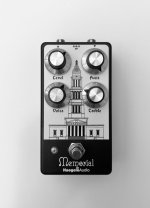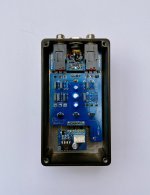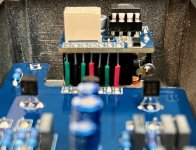PedalBuilder
Well-known member
- Build Rating
- 5.00 star(s)
This is a pretty straightforward and fun build. The Terminal Fuzz is an improved clone of the Shin-Ei Companion Fuzz. The Terminal cicuit incorporates the output boost stage from the General Guitar Gadgets Companion Fuzz and adds two additional controls: a 250k pot wired as a variable resistor in series with the input (Fuzz) and a 10k pot wired in series with one side of the notch filter (voice). The result is a much more versatile and useable take on the Companion Fuzz that still lets you get all of the nasty fuzz tones that put the original Companion Fuzz on the map. I used BC549 transistors from Tayda for all three transistors (hFE ≈ 220). There is some debate as to the correct value for the input capacitor for Q2. The Companion Fuzz used a 47n, but multiple traces found a 4.7n in the Terminal. I tried both, and the 4.7n sounded much better to my ears. The 47n was a lot more muffled and required the treble to be turned at least halfway up before it started sounding good. So if you want a really great 60's style silicon fuzz, grab the Depot Fuzz PCB and go build something. It's easy, sounds great, and doesn't require any exotic components.
For artwork, I wanted something that shared the appearance of the Terminal Fuzz, but with a local twist as I'm not from Ohio. If you look closely, the PCB layout echoes the artwork. The enclosure is a 125B from Tayda with their matte black sand powder coat, UV printed with two passes of white and matte varnish.


For artwork, I wanted something that shared the appearance of the Terminal Fuzz, but with a local twist as I'm not from Ohio. If you look closely, the PCB layout echoes the artwork. The enclosure is a 125B from Tayda with their matte black sand powder coat, UV printed with two passes of white and matte varnish.




